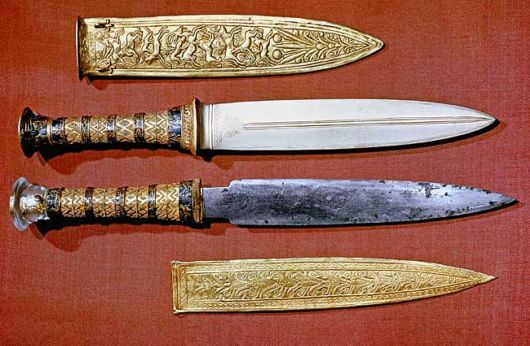
PHOTO: TreasureNet
CAIRO, EGYPT – Researchers from Milan Polytechnic, Pisa University, and the Egyptian Museum in Cairo itself discovered that King Tut’s dagger is literally from space.
It’s the dagger that, in 1925, Archaeologist Howard Carter found at the boy-king’s mummified right thigh. It was determined originally the dagger was made of iron, that much was really easy to figure out, but recent leaps in technology in the archaeological field of study have made it possible to determine the iron in the dagger’s exact origins: namely, a meteorite. One that fell from space thousands of years ago to crash into the earth, and one that was probably recognized as an omen, and subsequently turned into a precious object for a dead boy-king’s tomb.
It’s fine blade made from non-rusted, homogeneous iron. It has a gold handle, and its sheathe is decorated with the popular motifs found all over King Tutankhamen’s tomb: lilies, feathers, and a jackal’s head. The dagger was buried with him so that he would have it to use in the life to come. Lilies go all the way back to the Egyptian ‘lotus’, a flower that was there at the creation of the world that rose from the primal waters. The feather usually represented Maat, the ancient Egyptian concept of truth, balance, order, harmony, and law. The feather of truth would help the boy-king pass into the next life smoothly. The jackal head is for the god Anubis, the ancient keepwr of the dead.
How did they discover that his blade was made from iron that originated in a meteorite? Well, it is, in fact, quite easy. Apparently, Meteoric iron is clearly indicated by high percentages in nickel, with minor quantities of cobalt, phosphorus, sulfur, and carbon. To give you a bit of a reference, most iron artifacts are about 4% nickel. King Tut’s dagger is nearly 11%. It contains almost three times the usual amount found in iron artifacts of non-meteoric origins. According to researchers, the cobalt ratio is also consistent with iron meteorites, too.
Not only did they discover the general origins of the blade to be from outer space, but they also may have located the exact meteor shower where the iron for the blade was originally mined from.They looked over all the records of the meteorite fragments found within a 2,000 km radius of the Red Sea. Out of all the meteorites there, twenty of them were iron. Only one matched the nickel and cobalt contents of King Tut’s dagger exactly. It’s called Kharga. It was found on a limestone plateau in a seaport 150 miles west of the famous ancient city of Alexandria.
It’s a historic discovery that has led to more inquiry about the artifacts in King Tut’s tomb. The dagger isn’t the only artifact found in the boy-king’s collection to be made from materials from outer space. The mummy’s necklace has an amulet scarab made from Libyan desert silica glass produced by the impact of a meteorite or comet. This glass only exists in the Great Sand Sea of Egypt, a place that sounds like something out of a fantasy story. It would have been a 500 mile journey across inhospitable desert just to retrieve the materials needed to make such a piece of jewelry.
Clearly, ancient Egyptians held meteoric iron in high repute. Many objects have been recovered in various pharaohs’ tombs throughout Egypt that were created from natural glass or meteoric iron. Perhaps they believed the celestial iron was a message from the gods. Or, perhaps they believed that the celestial iron would help bear their god-kings safely into that mythical, sought-after life beyond death that was so important to them.

